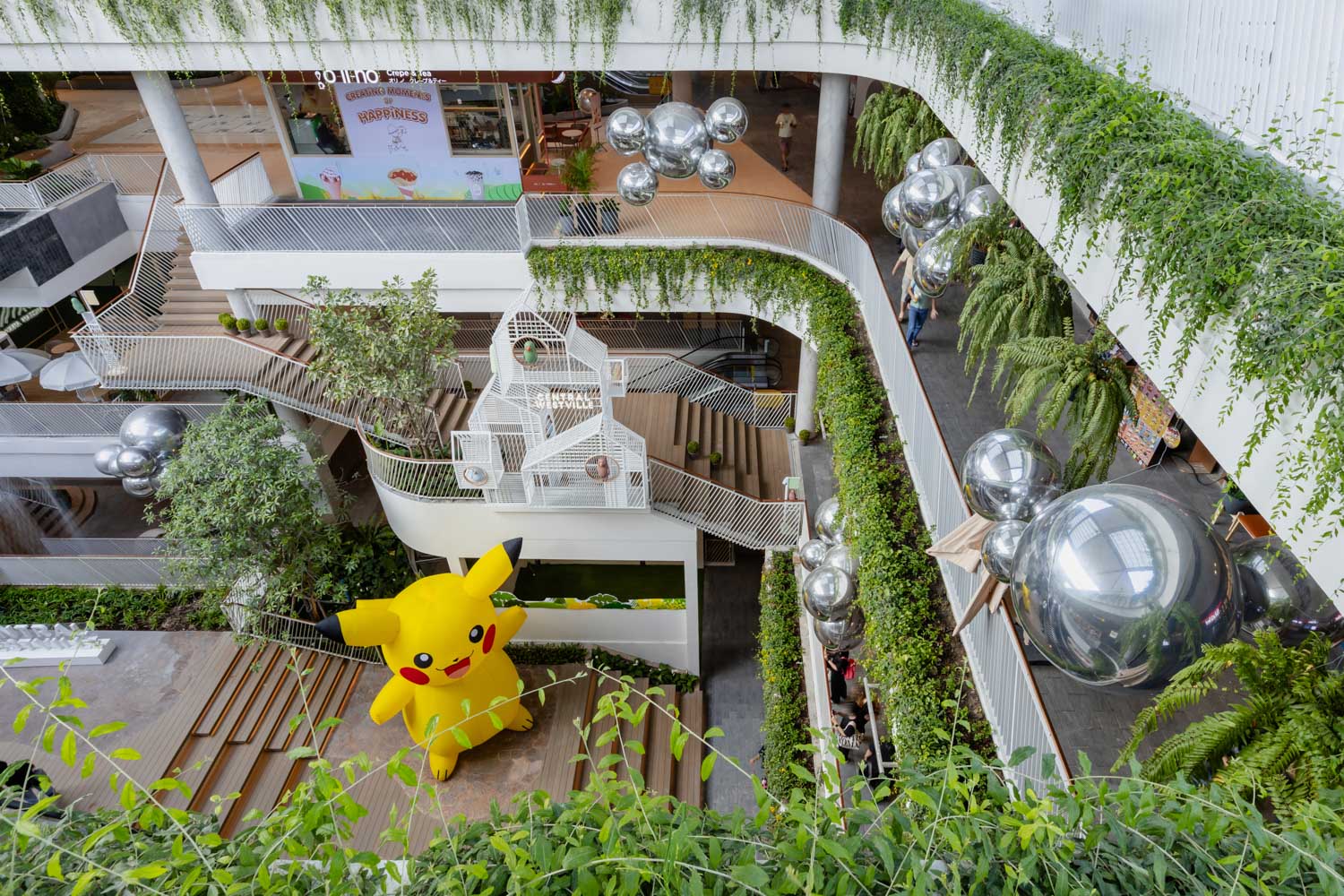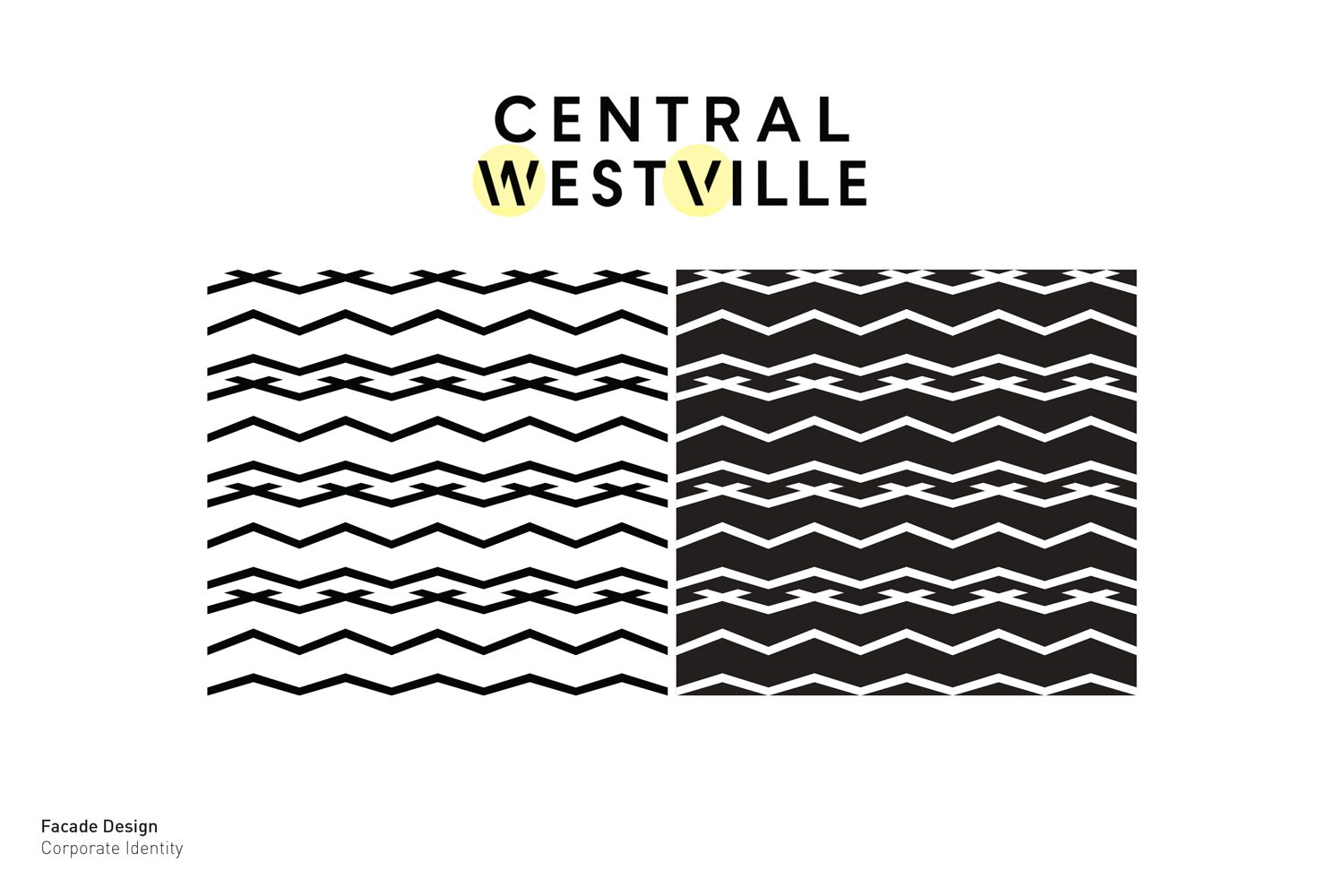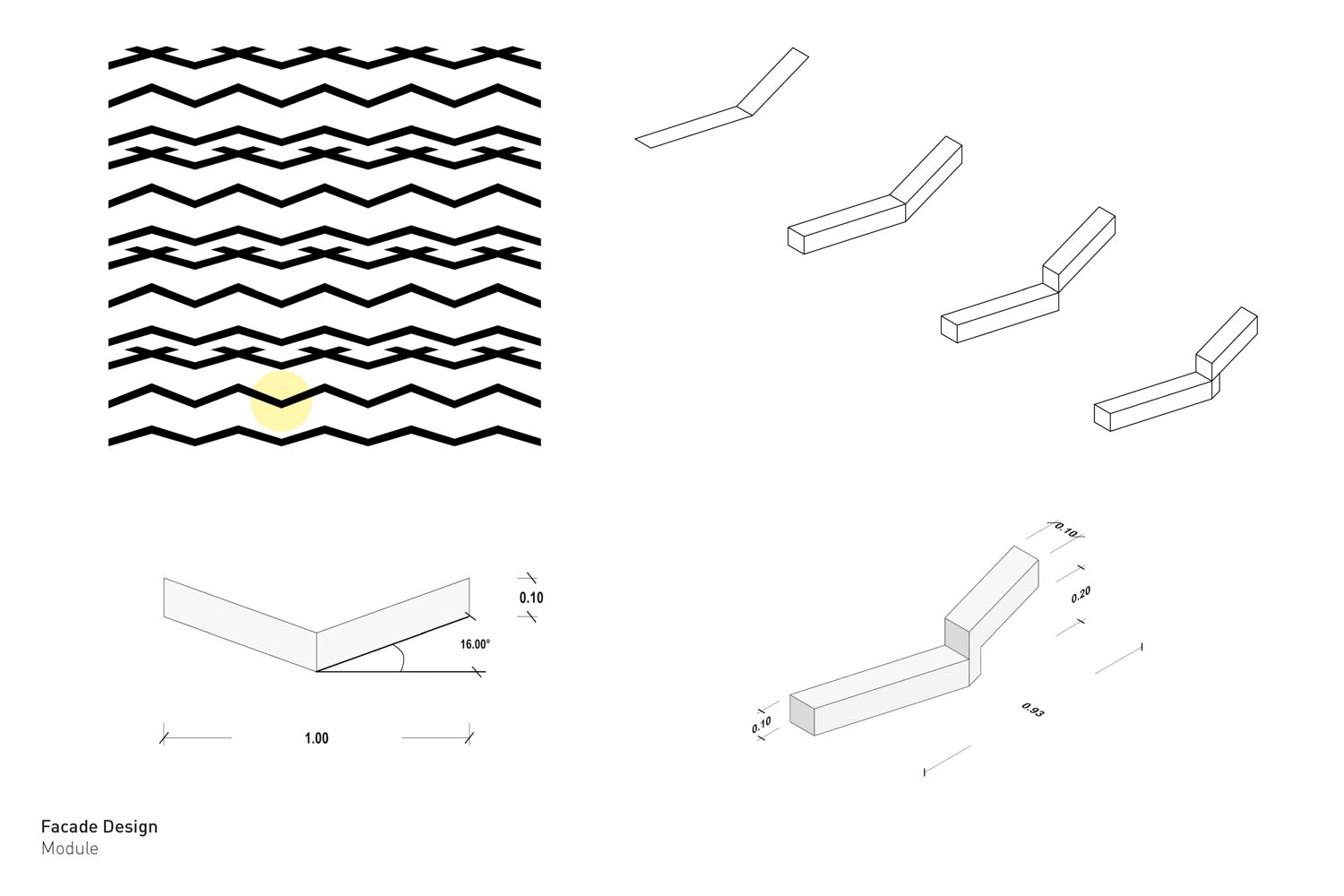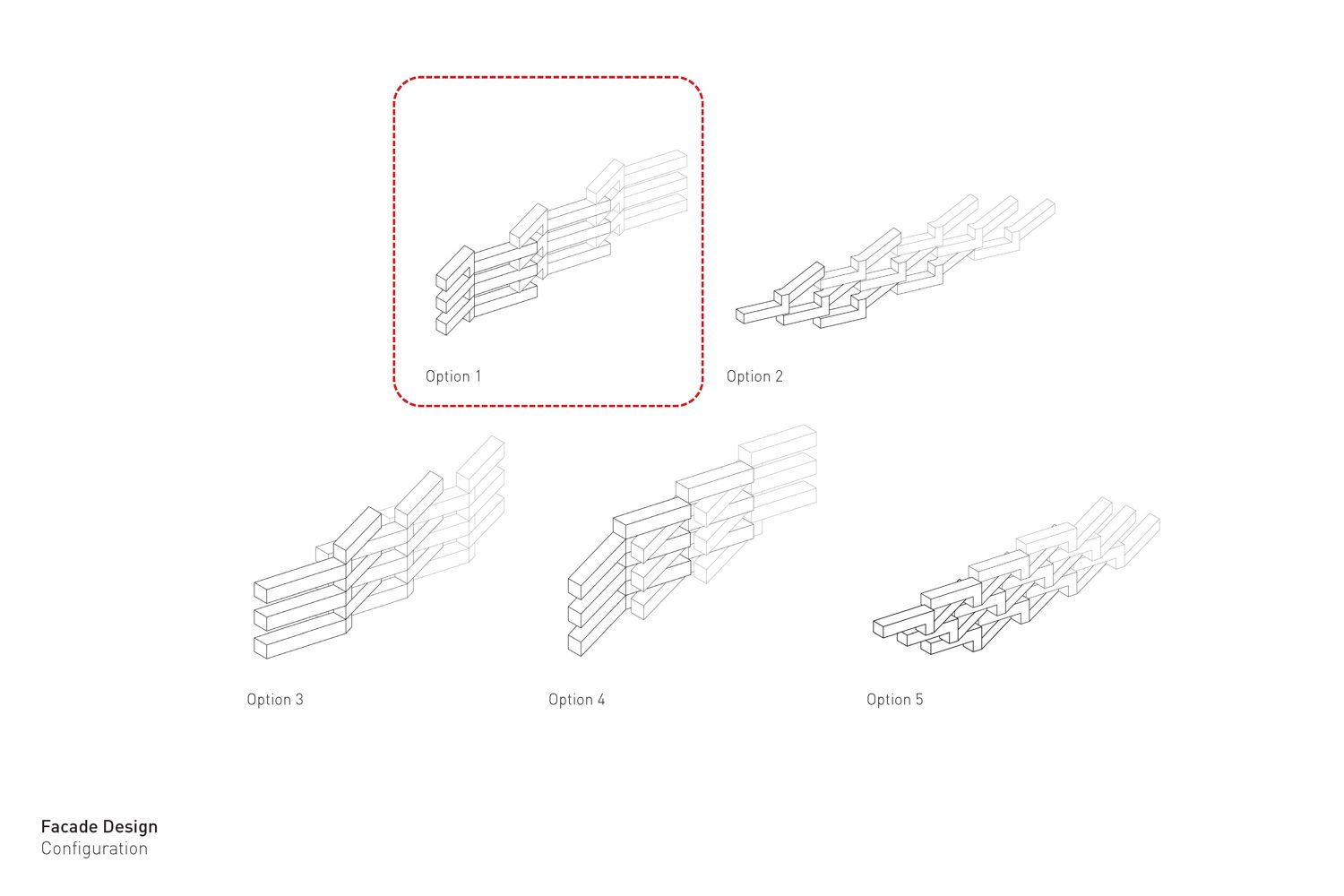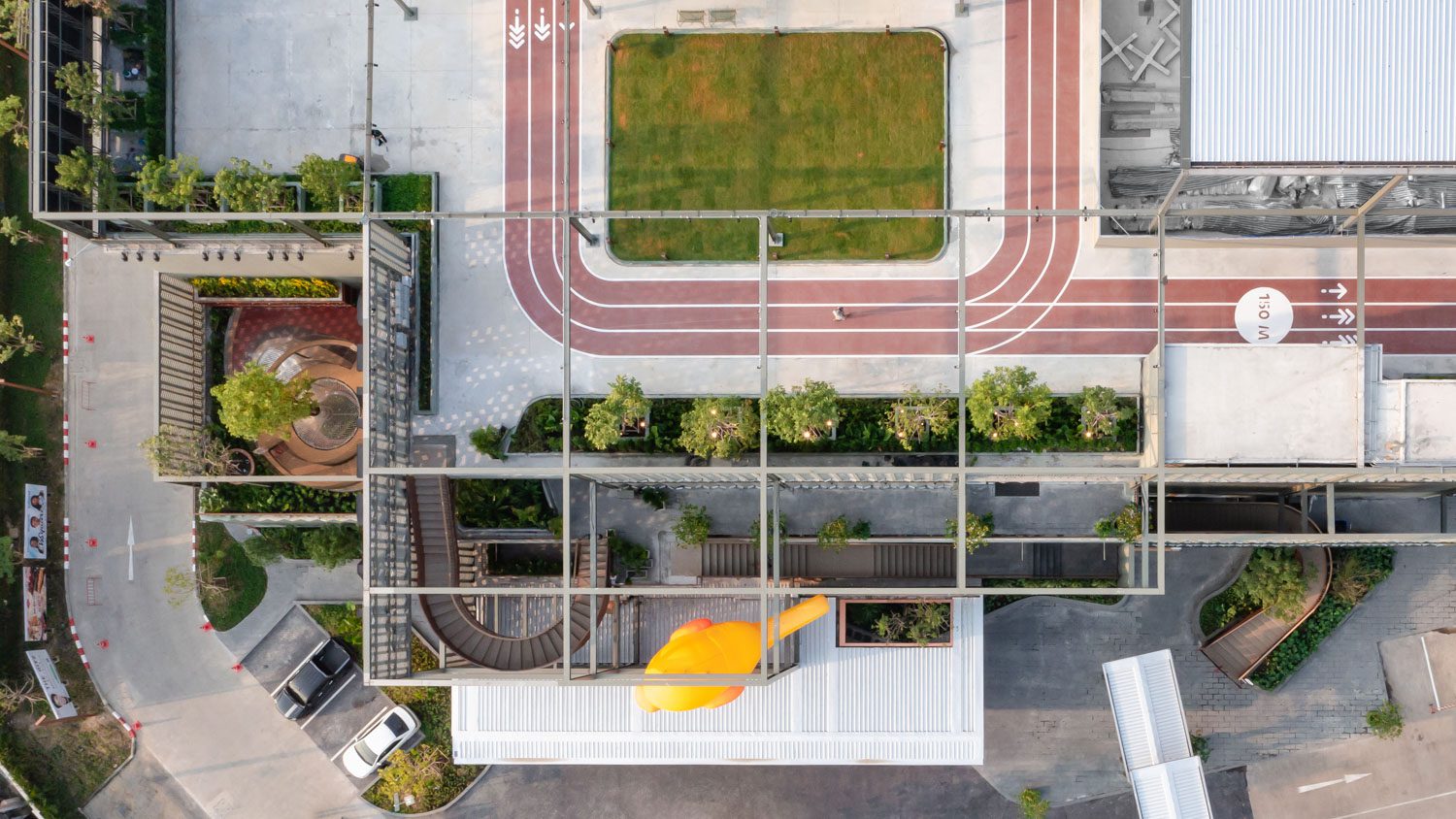Central Westville บนถนนราชพฤกษ์ เสนอแนวคิดเชื่อมต่อกับธรรมชาติ เป็นมิตรต่อสิ่งแวดล้อม ผ่านพื้นที่ semi-outdoor ที่เปลี่ยนภาพจำการมาห้างเพื่อตากแอร์
TEXT: PRATCHAYAPOL LERTWICHA
PHOTO: KETSIREE WONGWAN
(For English, press here)
ศูนย์การค้าที่เป็นตึกขนาดใหญ่ ข้างในติดแอร์เย็นฉ่ำ เชิญชวนให้ลูกค้าเดินเล่นจนลืมโลกภายนอก นี่อาจจะเป็นภาพศูนย์การค้าที่หลายคนคุ้นเคย แต่ตอนนี้เมื่อผู้คนโหยหาการใกล้ชิดธรรมชาติมากขึ้น และยังใส่ใจเรื่องสิ่งแวดล้อม การสร้างศูนย์การค้ายุคใหม่จึงยิ่งมีโจทย์ให้คิดรอบด้านมากขึ้นตามไปด้วย

Central Westville ศูนย์การค้าแห่งใหม่ล่าสุดจากเซ็นทรัลพัฒนา ตั้งอยู่บนที่ดินผืนใหญ่กว่า 40 ไร่ในย่านราชพฤกษ์ ฝั่งตะวันตกของกรุงเทพฯ ที่นี่ได้ Stu/D/O Architects มารับผิดชอบงานสถาปัตยกรรม PHTAA living design และ Context Studio ดูแลงานออกแบบภายใน ส่วนงานภูมิสถาปัตยกรรมเป็นผลงานของ Field Landscape Studio

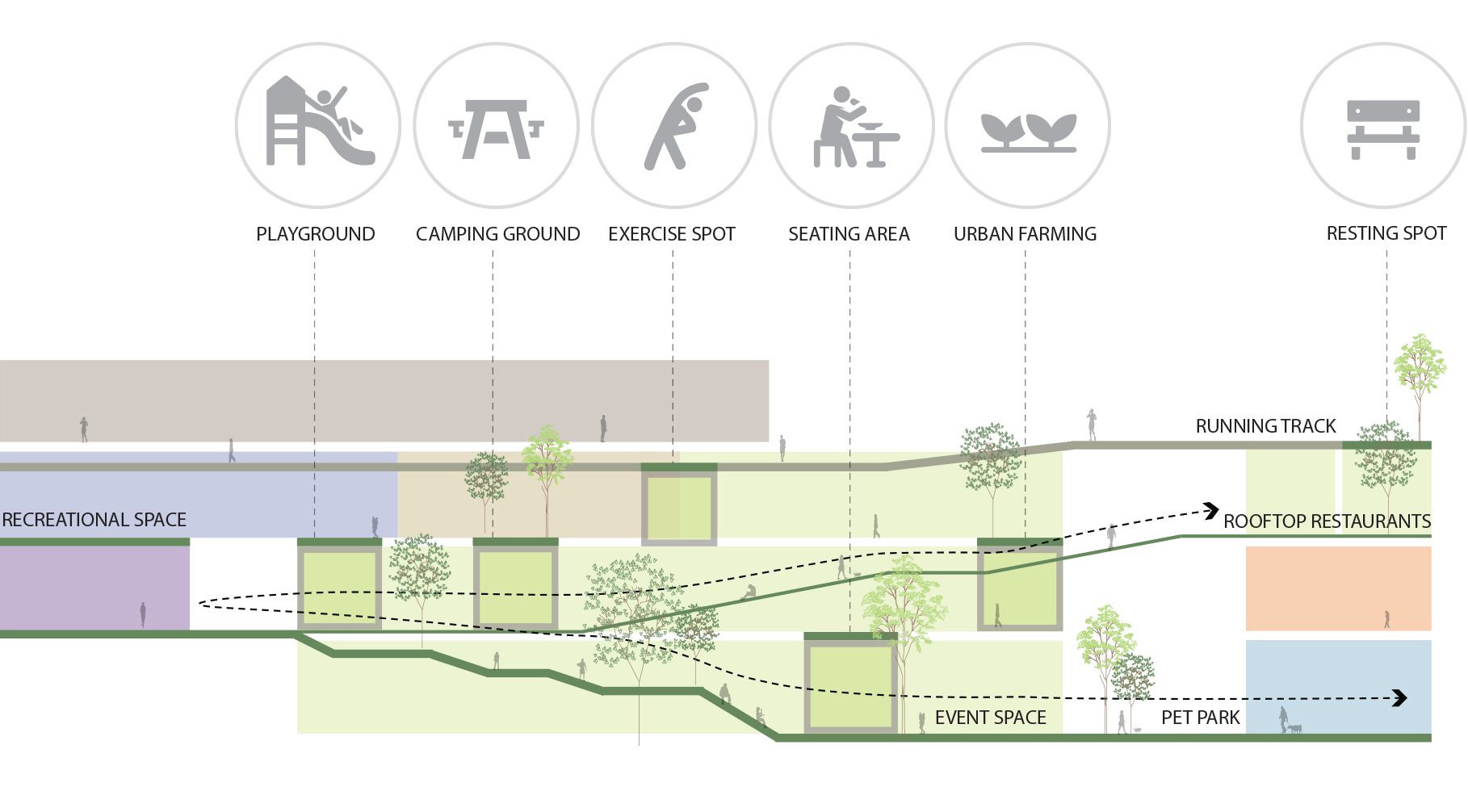
ไดอะแกรมแสดงแนวคิดการเชื่อมต่อของแต่ละชั้น
ผังของโครงการวางตัวเป็นรูปเกือกม้า ประกอบด้วยส่วน Central Department Store หรือส่วนห้างสรรพสินค้าที่รีโนเวทใหม่ทางปีกทิศใต้ และส่วนศูนย์การค้าที่สร้างขึ้นใหม่ในปีกทิศเหนือ ใจความของการดีไซน์คือการผนวกธรรมชาติเข้ามาเป็นส่วนหนึ่งกับศูนย์การค้า และชูความเป็นมิตรต่อสิ่งแวดล้อม พื้นที่ที่แสดงไอเดียนี้ได้อย่างชัดเจนที่สุดก็คือพื้นที่ semi-outdoor หรือพื้นที่กึ่งภายในภายนอกที่เปิดรับสายลมกับแสงแดดธรรมชาติให้ส่องลงมา ไม่ได้ติดเครื่องปรับอากาศในส่วนทางเดินเพื่อลดการใช้พลังงาน เป็นการพัฒนาต่อยอดโมเดลพื้นที่ semi-outdoor จากศูนย์การค้า Central Eastville ในฝั่งกรุงเทพฯ ตะวันออก ที่ประสบความสำเร็จมาก่อน
ถึงจะอยู่ภายในกรอบอาคาร แต่โซน semi-outdoor กลับให้ความรู้สึกเหมือนอยู่ภายนอก และอยู่ท่ามกลางธรรมชาติเสียมากกว่า อาณาบริเวณห้อมล้อมด้วยต้นไม้นานาพันธุ์ที่มอบร่มเงาและความชุ่มชื่น วัสดุตกแต่งเป็นวัสดุภายนอกที่มีเนื้อสัมผัสดูเป็นธรรมชาติ และเป็นมิตรกับสิ่งแวดล้อม อย่าง stamped concrete หรือไม้เทียม ช่องโล่งที่เจาะตามจุดต่างๆ ช่วยเชื่อมมุมมองระหว่างชั้นบนกับชั้นล่างให้เห็นกันได้อย่างทั่วถึง
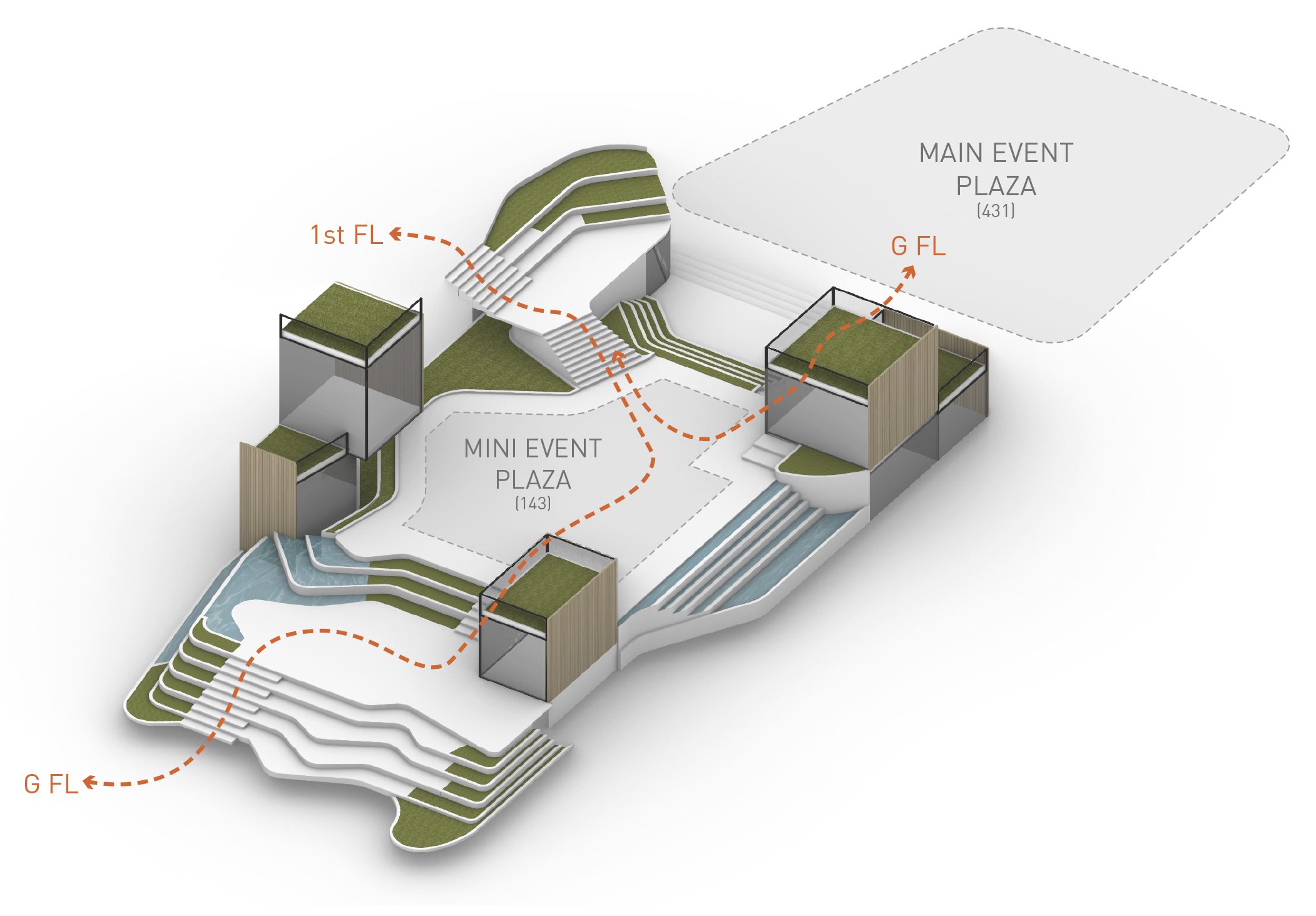
isometric diagram ของส่วน nature trail ใจกลางพื้นที่ semi-outdoor
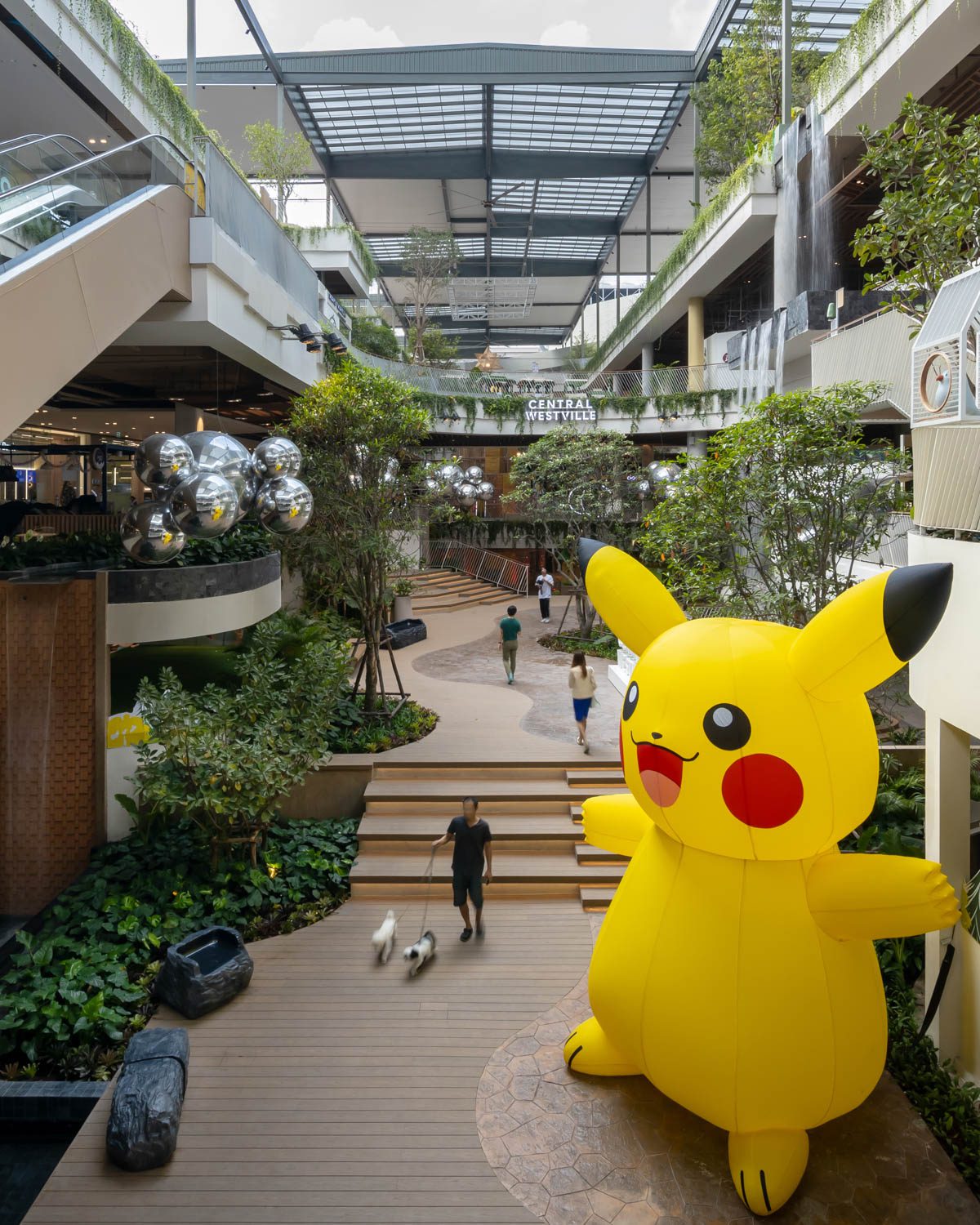

ไฮไลต์ของโซนนี้คือพื้นที่เปิดโล่งใจกลางที่สถาปนิกเนรมิตเป็น ‘nature trail’ เชื่อมต่อบรรยากาศธรรมชาติอันรื่นรมย์ตั้งแต่ชั้นล่างไปจนถึงชั้นบน ตรงกลางของช่องโล่งคือเนินภูเขาขนาดย่อมที่เปิดทางเดินให้ขึ้นได้ทั้งสองทาง คือรับคนที่เข้าจากประตูด้านหน้า และคนที่ขับรถมาซึ่งเข้าจากประตูด้านหลัง บนภูเขาคือทางเดินที่เชื่อมต่อไปหาแต่ละชั้น น้ำตกที่ส่งเสียงซู่ซ่าไม่ใกล้ไม่ไกลกล่อมเกลาการเดินบนขั้นบันไดไม่ให้เหนื่อยล้าน่าเบื่อ

Atelier Ten บริษัทที่ปรึกษาด้านความยั่งยืนของสิ่งแวดล้อมอาคาร ร่วมรังสรรค์พื้นที่กึ่งภายใน-ภายนอกกับสถาปนิก เพื่อให้พื้นที่นี้น่าเดินโดยไม่ต้องพึ่งความเย็นจากแอร์ โดยรอบบริเวณมีการเจาะช่องโล่งและติดตั้งพัดลมใบใหญ่เพื่อให้อากาศถ่ายเททั่วถึง มีการคำนวณปริมาณแสงแดดที่ส่องลงมาให้เหมาะสม ทั้งกับคนที่เดิน และทั้งกับบรรดาต้นไม้เพื่อให้เติบโตงอกงาม ถึงพื้นที่ภายในจะเปิดโล่งจนสายฝนโปรยปรายเข้ามาได้บ้าง ทีมดีไซน์ก็มีการวางเส้นทางการเดินเพิ่มเติมเพื่ออำนวยความสะดวกให้ทุกคนเดินได้โดยไม่เปียกฝน และออกแบบระบบการระบายน้ำเพื่อไม่ให้พื้นเลอะเทอะเปียกปอนจนเกินไป
ไอเดียเปิดรับภายนอกเข้ามายังภายในไม่ได้จบแค่โซน semi-outdoor แต่แนวคิดนี้ยังสะท้อนไปที่ส่วน façade ด้านหน้าอาคารด้วย สถาปนิกทลายเปลือกที่ทึบตันให้โปร่งโล่ง เปิดรับสายลมให้พัดผ่านและเชื่อมต่อมุมมองข้างนอกข้างในให้ทะลุถึงกัน กรอบอาคารออกแบบมาเป็นกริดสี่เหลี่ยมที่ยื่นหุบอย่างมีลูกเล่น
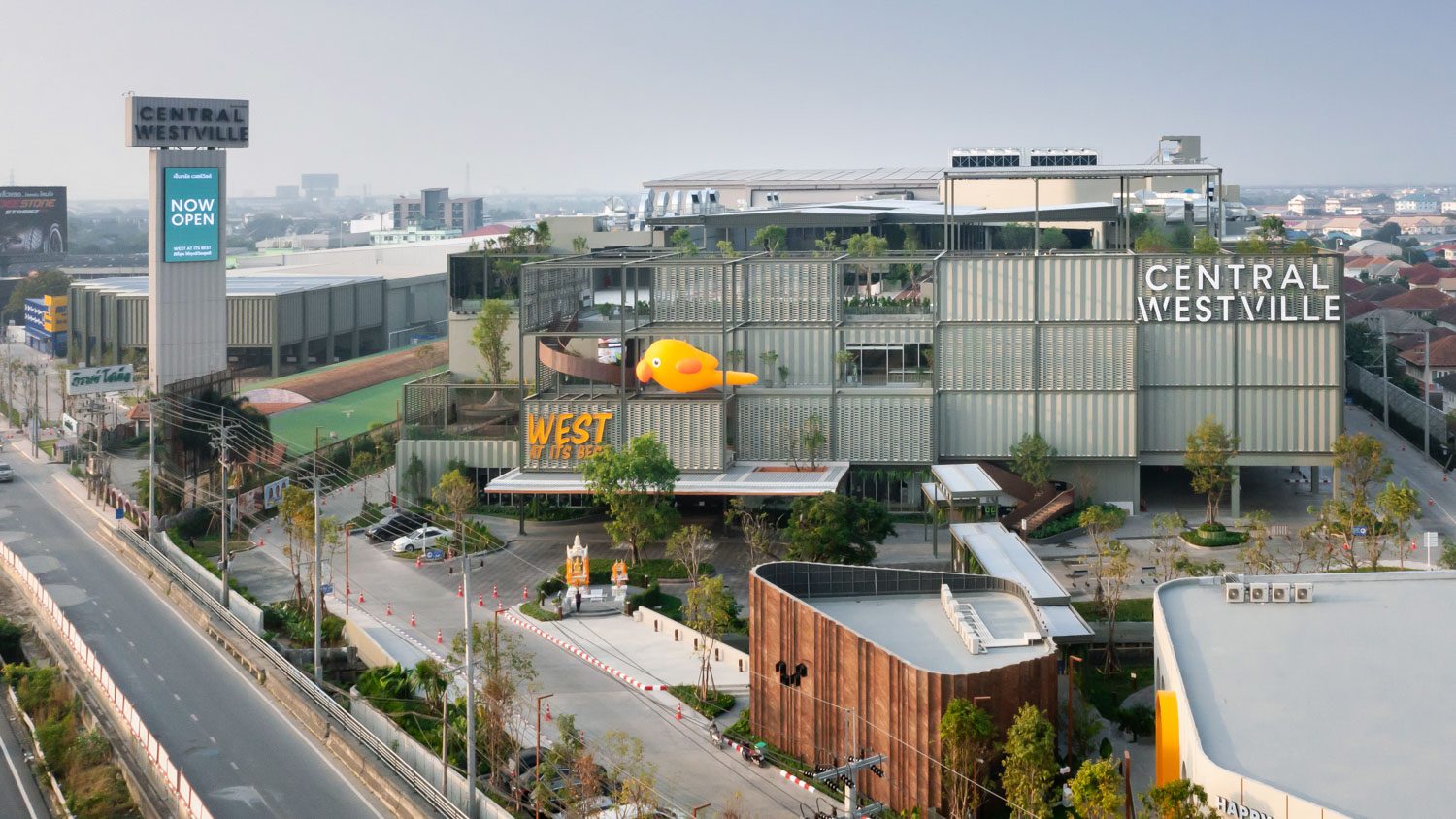
ส่วนผิวที่กึ่งทึบกึ่งโปร่ง คือการนำกราฟิก corporate identity มาคลี่คลายเป็นแพทเทิร์นโดยใช้ cement foam เป็นวัสดุในการก่อสร้างแทนการใช้อิฐซึ่งมีน้ำหนักเยอะกว่า ส่วน façade อาคารฝั่งที่รีโนเวทจากโกดังเก่าก็ใช้แพทเทิร์นและวัสดุเดียวกัน แต่แนวกรอบอาคารจะหยักซิกแซก เป็นความต่อเนื่องและแตกต่างอันเฉพาะตัวของทั้งสองฝั่งในเวลาเดียวกัน

ไดอะแกรมแสดงแนวคิดการสร้าง façade อาคาร

บนเปลือกอาคารเกิดพื้นที่ก้ำกึ่งระหว่างภายนอกและภายใน ซึ่งบริเวณนี้มีบันไดวิ่งยาวพาดผ่านตั้งแต่ชั้นล่างสุด ไปจนถึงส่วนลู่วิ่งข้างบน เปิดให้ลูกค้าขึ้นไปออกกำลังกายด้านบนได้ ในเวลาที่ส่วนศูนย์การค้ายังไม่เปิดทำการ ตัวบันไดหุ้มด้วยเหล็ก corten steel สีน้ำตาลที่ตัดกันกับสีอาคารโทนเขียวเทาอันโดดเด่น สร้างสีสันอันน่าดึงดูดให้อาคาร แนวกริดเหล็กที่ยื่นออกมาจากผนังทอดยาวต่อเนื่องไปที่แนวหลังคาด้านบน กลายเป็นโครงสร้างที่เอื้ออำนวยกับการตกแต่งต่อเติมเวลาจัดงานอีเวนต์ต่างๆ ชั้นบน

เหตุผลของการไปศูนย์การค้าไม่ใช่การไป ‘ตากแอร์’ อีกต่อไป แต่เป็นการไปรับบรรยากาศสดชื่น ผ่อนคลาย เหมือนได้ดึงตัวเองให้หลุดออกไปจากกรอบกำแพง จากดีไซน์ที่เชื่อมต่อภายนอกภายในและผสมผสานกลมกลืนของงานสถาปัตยกรรม งานออกแบบ Interior และภูมิสถาปัตยกรรมเข้าด้วยกัน Central Westville เลยเป็นอีกต้นแบบศูนย์การค้าที่ตอบโจทย์พฤติกรรมคนเมืองที่เปลี่ยนไป และตอบรับกับแนวโน้มโลกสมัยใหม่ที่ใส่ใจสิ่งแวดล้อมและความยั่งยืน


